How To Update Document Of Autodesk Forge Object
Sometimes numbers and charts aren't enough to communicate actionable information, in these cases we turn to Vcad for interactive model filtering and highlighting. However, these aren't the only things nosotros can do with Vcad. Applying themed colors to our model tin exist a simple manner to communicate complex data in a universal linguistic communication.
In this article we will have a look a how we tin can setup information-drive object coloring in our BIM files, using Vcad.
In this case we will be using the forge viewer version of Vcad with a Revit file, merely the functionality remains the aforementioned with any file type using the forge viewer.
Scenario
For this example, let's paradigm we have a BIM model of a building and an external data-source that provides data virtually installation progress of some equipment in our building.
The objective is to create a report with an interactive rendering of our BIM model and to color the objects of our model based on their installation status. This will let the written report user to identify at a glance which equipment has been fully installed in our building and which must nonetheless exist started.
Process
Here are the steps we volition exist executing to create our report:
- Download a preconfigured Power BI template based on the BIM file.
- Imports and transform the external data-source.
- Configure the color theming.
- Complete the written report.
Downloading the Power BI template
Beginning, nosotros must download the preconfigured Ability BI template from the Vcad portal.
This stride is described in this article, then we won't become through information technology here.
At the stop of this step, we will have a preconfigured Power BI template, setup with the model's and the Vcad custom visual configured to return the model.
Now we simply need to open up the template using the Ability BI desktop application.
Getting the external information
This step volition vary depending on the nature and structure of the external data to import in the report.
Import installation progress data
In this case we are importing information on the installation status of railings and grab-bars in a hospital. The data is stored in a file called "installation_progress.csv" which nosotros can import using the Home -> Become Information button in Ability BI Desktop, this volition add to our report a new dataset called installation_progress.
For simplicity, the dataset includes the objectId, the property used to link the rendered model with the rest of the report information, however this connection may be based on several other parameters like the object name of whatsoever of the defined backdrop.
The imported file, in .csv format, is structured as follows:
- objectId: reference to the model object id, generated by Forge when processing the model.
- progress: an integer value between 0 and 100, which provides the per centum of progress on the equipment installation.
- startDate: the date on which the installation began. May be empty.
- endDate: the date on which the installation was completed or considered usable. May be empty.
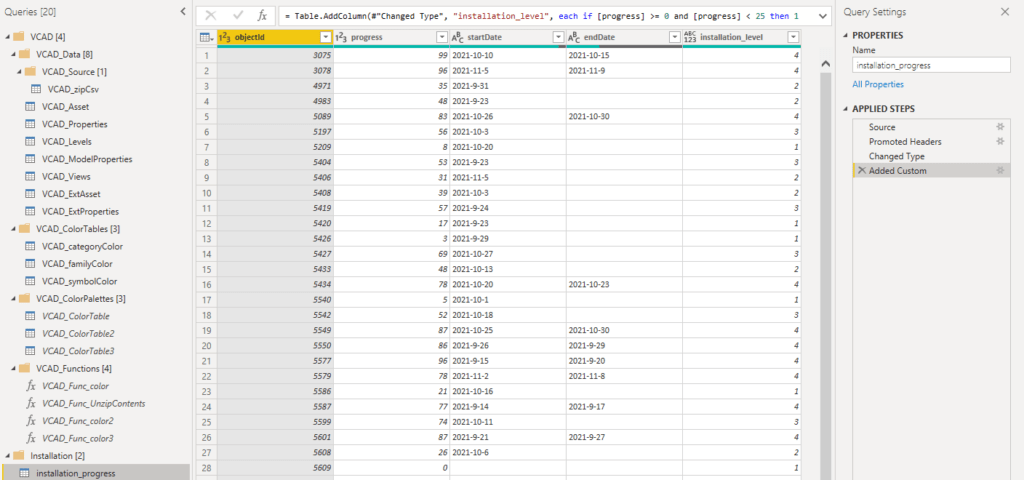
Create installation levels table
To assign colors to the model assets nosotros should define a categorization of the objects based on their completion status. To do then, let's create a dataset that lists the various installation levels and a color to represent them.
To add this dataset, we can simply open the Power Query Editor by using the Dwelling -> Transform information button, and then add together a new dataset past clicking on Dwelling -> Enter Data.
At present we tin define our installation_levels dataset with our installation level classification. In this example we will define iv levels based on 25% increments of level completion.
It is important that the dataset include:
- A level identification column: which can but be an incremental integer.
- A hex color lawmaking column, which will be used later to apply the color to assets in the model.
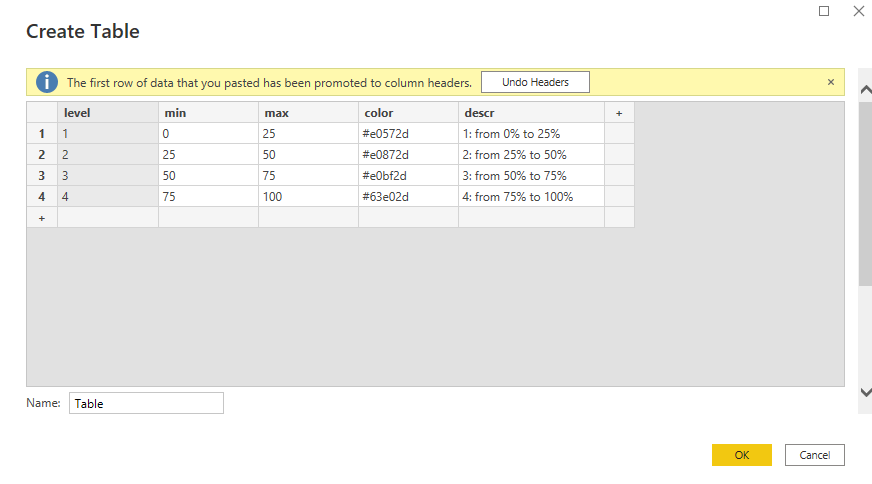
Note: The rest of the columns shown in the paradigm are extra information for season and formatting purposes.
Transform installation progress data
Now that we have imported our installation progress data and defined installation level colors, we take to apply the necessary transformations to exist able to connect the 2.
To practice then, we can select the installation_progress dataset and then click on the Add Cavalcade -> Custom Column button. This volition open up the column creation window where nosotros can define the formula for our custom column, which we volition call installation_level.
The column we add will so be matched with the level identification column from the installation_levels dataset.
For our instance the following formula will work:
if [progress] >= 0 and [progress] < 25 then i else if [progress] >= 25 and [progress] < l and then two else if [progress] >= 50 and [progress] < 75 then 3 else 4 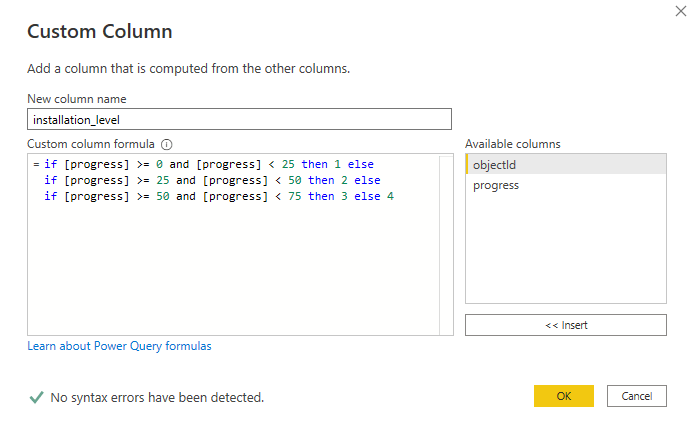
Link the datasets
At this point we are able to connect our two new datasets using Power BI'southward Model View.
The following relationships must be added:
- Installation_progress – VCAD_Assets: A 1-to-1 relation using the objectId columns from each dataset. This relation volition connect the installation data to the automatically extracted data from our BIM file.
- Installation_progress – installation_levels: many-to-one relation using the installation_level and level This relation will connect the defined colors to the installation progress information.
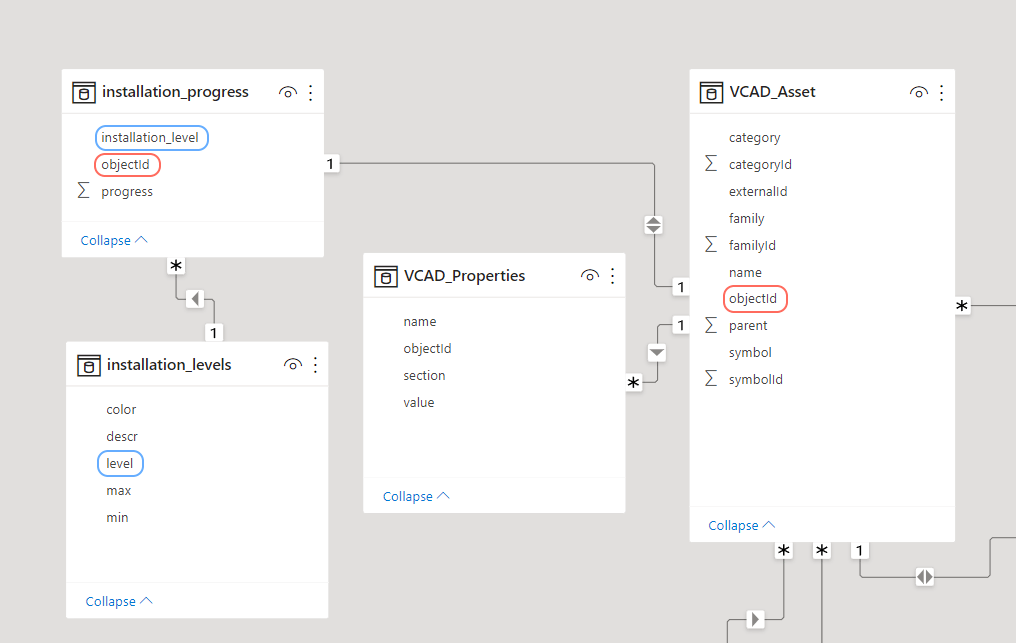
Configuring the Vcad custom visual
Now that the data has been imported and correctly linked, nosotros tin can go on with configuring the color theme.
To do and then, we tin select the custom visual and caput to the Format panel and then activate the Show Theme Color option. This will actuate a drop-downwardly menu on the top-left corner of the visual, that can be used to select the current coloring theme.
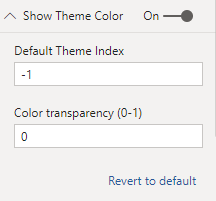
Finally, nosotros can switch to the Fields panel and drag our color column from the installation_levels tabular array to the Highlight Color field.

Completing the report
At this indicate we are skilful to go.
By using the theme selector inside the visual we can apply the new themes to the model, and by adding slicers and filters to the report we can easily filter and focus on the elements being analyzed.
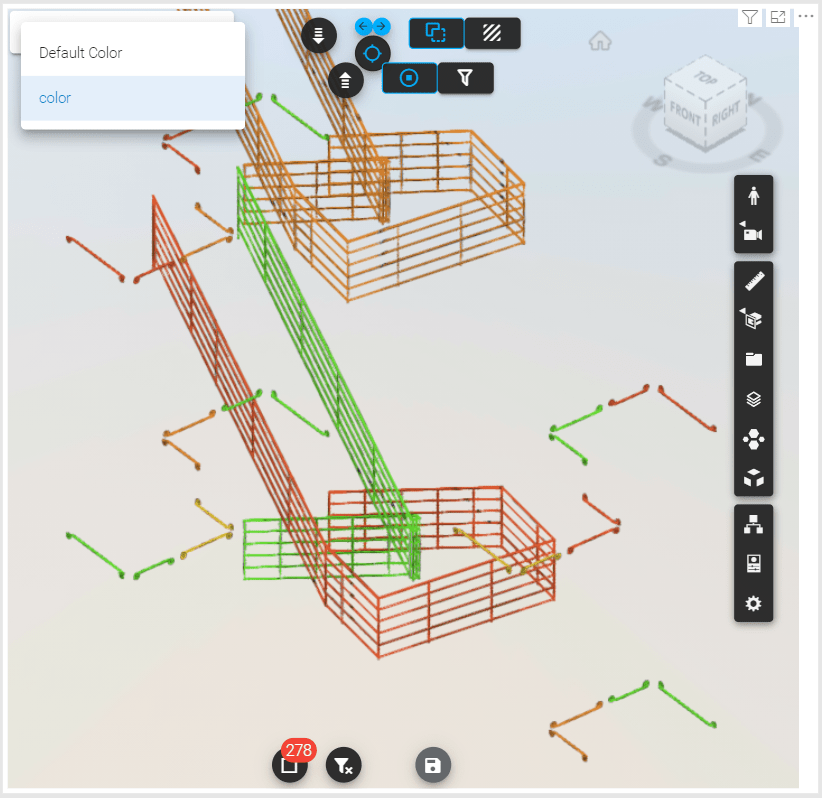
Conclusion
In this commodity we showcased how nosotros can add together colors to our BIM model to convey additional data in our reports.
For a footstep-by-footstep video guide have a wait at the video below.
How To Update Document Of Autodesk Forge Object,
Source: https://www.bimservices.it/themes-and-color-using-the-forge-viewer/
Posted by: phillipsturam1995.blogspot.com


0 Response to "How To Update Document Of Autodesk Forge Object"
Post a Comment